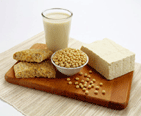The main source for cholesterol is the consumption of fat, which not only stimulates the increase of cholesterol level in blood but also is a reason for obesity. Obesity on its own part contributes to the cholesterol level increase. Thus individuals starting with children and finishing with their grandparents should be very aware of what they eat and be physically active, so that the level of cholesterol would be high enough to fully perform all its bodily functions, and low enough not to cause heart disease, stroke or diabetes.
Low fat low cholesterol diet
 Low cholesterol diet is specially created to reduce fat and cholesterol levels evaluated and recommended by the National Cholesterol Education Program (NCEP). They try to decrease total dietary fat, especially saturated fat; lower the amount of dietary cholesterol; limit consumption of sodium; increase the consumption of fiber and complex carbohydrates instead; and finally lower the amount of calories in order to reach a healthy body weight (in case of obesity.)
Low cholesterol diet is specially created to reduce fat and cholesterol levels evaluated and recommended by the National Cholesterol Education Program (NCEP). They try to decrease total dietary fat, especially saturated fat; lower the amount of dietary cholesterol; limit consumption of sodium; increase the consumption of fiber and complex carbohydrates instead; and finally lower the amount of calories in order to reach a healthy body weight (in case of obesity.)
All fat containing foods is a mixture of saturated and unsaturated fats. Saturated fat is the “devil machine” in the production of cholesterol in your body. There is no such a product that would increase your blood cholesterol level more than saturated fat. The easiest way to distinguish between saturated and unsaturated fat is observe their physical form: saturated fat solidify or remain solid at room temperature while unsaturated fat always remain liquid regardless to the temperature.
The biggest source of saturated fats is animal products, such as fatty meat, poultry (especially with skin), dairy products, lard. Some vegetable oils are also rich in this kind of fat, e.g. palm, palm kernel, and coconut oils. So the best way to avoid high blood cholesterol level is to choose food which is low in saturated fat. One of the possibilities is to replace fat-high products by foods such as vegetables and fruit, or whole grain products that are rich in starch and fiber.
Low cholesterol diet recipes
| Breakfast |
Grapefruit (1/2 cup); cereal (3/4 cup); banana (1/2); egg substitute (1/4); whole wheat toast (2 slices); margarine ( 2 tsp); jelly or jam (1 tbsp); drink 1% milk (1 cup); coffe/tea. |
| Lunch |
Vegetable beef soup (1 cup); lean hamburger (2 oz); low fat cheese (1 oz); hamburger bun; sliced tomato and lettuce with olive oil (2 tsp); fresh fruit salad (1/2 cup); oatmeal cookie (1); 1% milk (1 cup). |
| Dinner |
Tomato juice (1/2 cup); broiled chicken breast (3 oz); herbed brown rice (1/2 cup); broccoli spears (2); hard dinner roll (1); margarine (1 tsp); carrot/raisin salad (1/2 cup); frozen strawberry yogurt (1/2 cup); 1% milk (1 cup). |